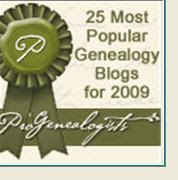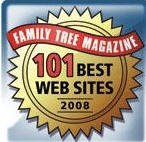The timing of this announcement is even more important, coming as it has during Chanukah - The Festival of Lights - celebrated by the global Jewish community.
MyHeritage.com and Beit Hatfutsot - the Museum of the Jewish People (Tel Aviv, Israel) are now collaborating in a major new project to preserve Jewish family trees.

Read on for an interview Tracing the Tribe conducted with the Museum's CEO Avinoam Armoni and more information about the new project.
Under this partnership, online family trees built on MyHeritage.com - with the consent of the tree creators (see below) - will be transferred to Beit Hatfutsot for digital safekeeping.
For three decades, Beth Hatfutsoth has been collecting digital information on many topics, all aimed at preserving the history of the Jewish people, including family trees with millions of records. Its multimedia database includes Jewish genealogy, surnames, communities, photographs, film/video and music.
MyHeritage.com is an international genealogical social networking site with 35 million members around the world and currently has some 9 million family trees. It operates in 36 languages, making it ideal for families to connect around the world, and offers easy and fun tools to enable sharing of information, photos, documents and videos among far-flung relatives.
It is the most popular genealogy website in Israel and in much of the Jewish world, making it a natural partner for this collaboration.
A few days ago, Tracing the Tribe interviewed the museum's new director Avinoam Armoni. Here's only some of what we spoke about.
The Museum has been through some tough times. At one point, during a severe economic crunch, the building was nearly shuttered. The Knesset voted assistance and then philanthropist Leonid Nevzlin generously stepped in to save the institution, founded in 1978 as the Museum of the Diaspora.
Tracing the Tribe had not met Armoni in person before our interview, but can now say that this photo (right) - received after our conversation - is exactly how I imagined him: Smiling, ebullient, articulate and enthusiastic.
He brings many essential talents to the position - his enthusiasm, understanding and broad knowledge of the Jewish world, combined with his business sense. Armoni has been a special adviser to the Edmund J. Safra Foundation and vice president of external relations at Hebrew University (Jerusalem), where he graduated in law. His Harvard University master's degree is in macro-economics and urban management.
It was inspiring to speak with someone so in tune with what could be accomplished.
"It's mindboggling what you can do with a little money and strategic thinking," Armoni shared enthusiastically.
A big believer in genealogy - as is MyHeritage.com's founder/CEO and avid genealogist Gilad Japhet - Armoni understands the relationships between Jewish people worldwide as well as Jewish identity. All of this bodes well for the new collaboration.
“We see it as a privilege to cooperate with Beit Hatfutsot and help it collect family trees from people who wish to participate, and preserve them for eternity," said Japhet. "In doing so, we not only take part in a project of significance on a historical scale, but we also fulfill our own goal of proliferating family history, an enriching and bonding human experience.”
The new collaboration will grow Beit Hatfutsot as a major respository for Jewish family trees and preserve Jewish identity.
How does it work?
Under this new project, all online family trees built via MyHeritage.com's special page or with its special version of the free software, Family Tree Builder - with the consent of the tree creators - will be periodically transferred to the Museum to update the database for digital safekeeping.
According to MyHeritage's database and translation manager Daniel Horowitz, all you need to do is go to the special MyHeritage.com page to accept the terms and conditions and create a free account to start building your family tree.
Armoni believes this will add millions of data elements to the Museum's genealogy database. He's "very optimistic" and thinks this kind of public/private partnership is the way to go.
The immediate benefits, as he sees it, is to offer the public free software from MyHeritage.com to create family trees, with the option to share those trees with Beit Hatfutsot. "Let us build the global Jewish family tree together," he stressed.
For 14 years, the Museum has also conducted the “My Family Story” international family tree competition for young people; over the years, some 200,000 students have participated. The family trees of participants will now be built on MyHeritage.com and become part of this database.
Until very recently, the museum did not have a proactive approach to enrich the databases, which include genealogy, video and film, photographs and music. That has now changed.
What does it mean to creators of Jewish family trees?
The museum is a national institute and data entrusted to it will have a permanent home forever. "I want Bet Hatfutsot to be the boidum (storeroom, Hebrew) of the Jewish people." Family history shouldn't be forgotten in your attic, he said. "Share it and preserve it for future generations."
The bottom line?
You and your family are part of the history of the Jewish people. By preserving your family tree at Beit Hatfutsot, help preserve your family's memory and history forever.
What's coming up at the Museum?
Armoni sees Beit Hatfutsot's future in technology. Although the Museum has no artifacts, it is a platform for education and discussion. Its databases, including genealogy, are the jewels in the crown. Armoni calls them the "Mona Lisa of the museum."
He's planning for a virtual online museum, and a board committee is already working on this project. A prominent Internet personality has been approached to head that committee. They've started - and will accelerate - digitizing the databases. In the near future, the website will be linked to the digitized databases and provide access.
Tracing the Tribe asked about other programming formats. Will there be workshops, seminars, classes? Armoni certainly understands both sides - paid and free - of such programming. While there's a definite need for revenue-producing events, he said, there's also a need for events which bring in no revenue but which promote Museum programs.
On a personal note, we discovered many connections during our conversation. They say there's a six degree separation between any two people; I think ours is fewer. In this regard, the interview was a surreal, Twilight Zone-experience.
As I have often written, I like to break interview ice with a genealogy question for the person being interviewed. Their original name? Their ancestral roots? A former Jerusalem Post editor once told me that not everything is about genealogy, but I disagreed then and now. Everyone wants to talk about their family knowledge or reasons for the lack thereof.
In Avinoam Armoni's case, his father arrived in pre-state Israel in 1926. The family name was Kestenbaum (chestnut) and his father simply translated the name into the Hebrew Armoni. The family's roots are in Lutsk and Kovel, and a cousin did a family tree some time ago.
"Out of the blue," he said, "we received an email a few years ago from someone in Argentina named Paul Armony." That was a surreal moments, as Tracing the Tribe and much of the Jewish genealogy world knew Paul z'l, whose kindness and genealogical accomplishments in Buenos Aires we'll always remember. And, yes, the two families are related.
The Museum has a fascinating collection of scale model historic synagogues from many cities. One is the fortress synagogue of Lutsk, which makes Avi's connection to the institution even more personal.
Tracing the Tribe asked about the current status of the Fehrer Music Archives, an amazing archive about which I often wrote in "It's all Relative" (Jerusalem Post, 1999-2005) and in this blog. It has been without a director for some time, following the departure of my friend Dr. Yuval Shaked. Under Yuval's care, the archive grew into a major world resource. I'm happy to report that plans are being made to revitalize this important resource.
Tracing the Tribe shared with Armoni what I consider one important element lacking at Beit Hatfutsot. What it needs, I said, is a major publicly accessible central Jewish genealogical reference library. We'll see.
Read the complete press release here.
























No comments:
Post a Comment